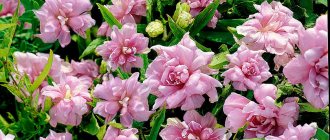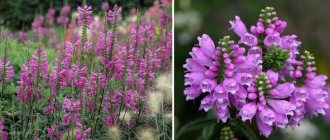- September 14, 2018
- Flowers
- Natalia Miroshnikova
Flowering vines look very impressive, and such plants are popular with gardeners. But not all such cultures are endowed with an unpretentious character. A pleasant exception to the rule is calystegia terry, which is also called the Siberian rose. With minimal care, this climbing plant grows quickly and delights with numerous and large buds.
Description
Calistegia terry is a climbing vine belonging to the Convolvulaceae family. This herbaceous perennial, which came to us from East Asia, is distinguished by a highly developed root system. The whitish dense shoots are capable of occupying a large area and displacing other crops from it. Therefore, the growth of the vine must be limited.
The plant's smooth and flexible vines, covered with brownish skin, reach 4 meters in length. They bear heart-shaped or triangular leaves, painted in light or dark green tones. The plates with a relief pattern on the surface have pointed tips and wavy sides.
But the main value of the vine lies in its large double buds. They densely cover the plant's vines from the beginning of summer until frost. The diameter of the peduncles reaches up to 10–12 cm. The thin delicate petals of the crop are colored pink or white. After the buds, seed boxes are formed. With the arrival of cold weather, all above-ground parts of the crop die off, only the strong rhizome remains alive, which will produce new shoots next spring.
Is it necessary to prune the plant?
Pruning for Calistegia is necessary for:
- giving it an attractive appearance;
- combating excessive thickening;
- prevention of diseases associated with insufficient air supply.
During the entire growing season, the following types of pruning are performed:
| Trimming type | Description |
| Sanitary | It involves removing faded buds, dried leaves, and broken branches. It allows the plant not to waste energy on “maintenance”, but to focus on the formation of new buds. |
| Molding | Shortening shoots that are too long is necessary to maintain the shape of the bush and prevent its excessive growth. |
| Complete pruning of the above-ground part | Performed when the plant stops flowering. It allows the rhizome to accumulate more nutrients and survive the winter safely. In addition, pruning is a means of controlling the spread of pests. |
Popular types
There are 25 varieties of vines, but only three are grown as ornamental crops. The rest grow like weeds. So, for the garden, choose the following types of plants:
- Calistegia fluffy. The plant is characterized by rapid growth and shoots reaching up to 4 meters in length. The strong branches of the vine are densely covered with leathery, oblong, emerald leaves. The buds are usually double. But there are varieties with simple bell-shaped peduncles. The diameter of the buds reaches 3–9 cm. The petals are painted in soft pink tones with a dark base.
- Calistegia multiplex. The shoots of the vine reach 3–4 meters in length. They are covered with dark green triangular shaped leaves. The plates are located close to each other, which gives special splendor to the branches. But the main value of the variety is its large double buds, reaching 10 cm in diameter. The petals are painted in bright pink tones. Calistegia multiplex is the most demanding of regular feeding.
- Calistegia ivy leaf. This variety is also called Japanese. The plant is characterized by rapid growth. Its shoots reach 1.5–2 meters in length. On the elastic branches there are small alternate leaves and large double buds with a diameter of up to 9 cm. The vine begins to flower in July and ends by the end of September.
Each of these varieties will decorate the site. But for this you will need to create comfortable conditions for the plants and provide the vines with minimal care.
Terry calistegia: types and varieties for open ground
Only a few varieties of the flower have been cultivated. The types of calistegia described below are most often used for cultivation.
Fluffy (pubescens)
Found wild in China. A liana with long shoots that reach 4 m. The leaves are leathery, slightly elongated. The flowers are pink-white, the core is dark. The most popular variety of the species is Flore plena, with soft pink flowers that look like pompoms. The plant begins to bloom in mid-summer.
Hairy
A perennial plant native to the Far East. Prefers to grow on rocky slopes and meadows, like a weed. It has stems up to 80 cm long, with elongated lanceolate leaves. The roots are long, cord-like. The flowers are pink, 4-6 cm in diameter, with a corolla formed by 5 fused petals.
Fence (Sepium)
A perennial with climbing thin shoots up to 3 m long. The leaf blades are triangular, the flowers are single, white or light pink. This species is found everywhere and grows like a weed.
Multiplex
Liana-shaped calistegia 3-3.5 m long. The leaves are dark green, triangular. The flowers are pink, about 10 cm in diameter. The species is highly frost-resistant.
Ivy (hederifolia) or Japanese (japonica)
A plant with strong elastic stems up to 2.5 m long. The leaves are small, arranged alternately. The flowers are about 9 cm in diameter, light pink.
Selecting a location
The plant does not tolerate transplantation well and grows in one place for up to 20 years. Select a site taking into account this feature of the vine. Calistegia is a light-loving flower. Therefore, the curly beauty requires the most illuminated open spaces. The southern or eastern side of the site is suitable, preferably on a small hill. Since in lowlands and places with close soil, the roots of the plant rot.
Do not grow the crop near buildings, high fences or in the shade of large trees. This will cause the color of the petals to fade significantly, and the flowering itself will occur two weeks later and will last less.
The vine does not have any special requirements for soil. But it develops better in areas with nutritious and loose soil. In such conditions, the plant lives up to 10 years and annually pleases with long and multi-membered flowering.
How to properly care for a plant
With proper care and choice of location, the vine will delight with lush flowering from mid-summer until the onset of frost.
Lighting
"French Rose" loves sunny places. To obtain abundant and early flowering, you must choose a well-lit place for planting. The plant is not afraid of direct sunlight, but in the shade it can greatly slow down the development of shoots and begin to bloom 2 weeks later. If a tree is chosen as a support, the crown should be openwork, creating a translucent shadow.
Top dressing
A fast-growing vine requires good fertilizer. In early spring, before the beginning of the growing season, it must be fed with organic fertilizers and humus, and the soil must be loosened well. Throughout the summer, to maintain abundant flowering, apply complex mineral fertilizer for flowering plants once every two weeks. After the end of flowering and growing season, the loach is cut off and the ground is mulched with ash.
Trimming
In the summer, to maintain a decorative appearance, it is necessary to prune faded flowers, this will promote the appearance of new buds. After the growing season, it is advisable to cut the shoots by 2/3 of their length, this will make it easier for the plant to overwinter and more young shoots will appear in the spring. You can even cut the plant down to ground level.
The soil
By regularly feeding the “French Rose” you don’t have to worry about the soil; sandy and loamy soil is suitable. By adding humus and compost every spring, you can extend the life of a plant in one place for up to twenty years. It will grow poorly on soils with close groundwater.
Watering
In temperate and southern latitudes, there is enough precipitation for calistegia. Powerful roots independently store water and can suffer from waterlogging caused by stagnation of water or the proximity of groundwater. It will only be necessary to water in the event of a very dry summer.
Landing
Start the event in early spring. Before planting, be sure to harden off the seedlings. Take them out into the fresh air for two weeks and leave them for an hour. Plant the plants in a trench 25–30 cm deep. If the groundwater in the area lies close to the soil surface, be sure to provide drainage. To do this, pour a 5-centimeter layer of broken brick or coarse sand onto the bottom of the trench.
Plant seedlings at a distance of 20 cm from each other. Make sure that the root collar is level with the ground. After planting terry calistegia, moisten the soil well and mulch the surface with peat or humus. This layer will feed the plants, also retain moisture in the soil and prevent weeds from appearing.
Please note that calistegia terry is a vine that grows strongly. And if its development is not controlled, it will quickly take over free space and displace other cultures from there. Therefore, limit its growth with pieces of slate, plastic or mesh tape 50 cm wide. Dig these materials around the crop to a depth of 40 cm.
Mr. Summer resident warns: problems with growing calistegia and its pests
When growing Calistegia, various problems arise, complicated by pest attacks:
- Rapid growth of the root system. If the part of the rhizome with young shoots is not dug up in a timely manner, the plant turns into a weed, which is removed with great difficulty. To prevent this, a growth limit is set. Its role is played by an ordinary lattice, dug into the soil or tripods.
- Slugs. If such pests are found on a plant, then the soil around the flower is sprinkled with lime. The plant is also treated with an insecticide such as Groza.
- Spider mite. During hot weather, such insects also appear on the foliage. They are eliminated with acaricidal agents like Aktara.
Care
Growing terry calistegia in the garden will not cause much trouble, because the vine is unpretentious and does not require special attention. However, in order to achieve lush and numerous buds from it, you will need to carry out such agrotechnical measures as:
- periodic watering;
- regular feeding;
- pruning and crown formation;
- preparation for winter;
- prevention of diseases and pests.
In addition, in order for the plant to develop well, it is important to provide it with support. For this purpose, use tripods, inclined rods, and gratings. If you wish, you can even build an arch, and terry calistegia will easily wrap around it. But keep in mind that the diameter of the support should not exceed 10 cm. Otherwise, the vine will have difficulty climbing it.
Calistegia terry in landscape design
Since the rootstock is a vine, it is ideal for landscaping vertical surfaces. They can be used to decorate mesh gazebos, terraces, and arches. Calistegia can be grown as a hedge. With the help of this plant, you can visually increase the area of the site if you make an opening of several arches along which it will weave. Bindweed is a bad neighbor for other plants in the flowerbed. It is better to plant it separately. It grows quickly, has a powerful root system and can simply choke out the growth of other crops.
Calistegia terry is a flowering vine that can decorate any landscape. This is an ideal plant for unsightly areas, walls and fences. Unlike many other decorative flowers, calistegia requires virtually no attention. But for long and abundant flowering it must be provided with sufficient light, moisture, and nutrients.
Below is a video from which you can find out more useful information for gardeners about the features of growing double Calistegia and using decorative vines for spectacular landscaping of the site:
Watering
Calistegia terry, photos of which are given in the material, is a drought-resistant plant. And it has enough groundwater and rainfall. But if the summer turns out to be hot and dry, then water the flower occasionally.
Young seedlings in the first year after planting need more frequent irrigation, because their roots are not yet strong enough and do not draw moisture from the soil. Therefore, moisten the soil as it dries. But don’t get carried away with watering, because young plants will die from stagnation of moisture.
Possible difficulties in growing
The biggest difficulty is restraining the active growth of the Calistegia root system. If left unchecked, it can capture a significant territory, which will subsequently be extremely difficult to clear. The most effective way to contain the green “aggressor” is to create an underground fence. In addition, do not neglect regular pruning of branches.
The second possible problem is an invasion of slugs and snails, which not only cause harm to the plant, but also spoil its appearance with their presence. Timely spraying with pesticides can rid Calistegia of uninvited guests.
You also need to remember that Calistegia is poisonous; if the leaves are swallowed (relevant if there are small children in the family), it can cause diarrhea, vomiting, and severe pain in the abdominal area. Otherwise, this unpretentious plant will not cause any trouble for the gardener, provided he follows the basic rules for caring for Calistegia.
Preparing for winter
Calistegia terry is a frost-resistant plant. And in the middle zone, it calmly endures the cold season even without shelter. But if a frosty and snowless winter is expected, then it is better to prepare the crop for it. To do this, cut off all above-ground parts of the plant, because they will die from frost anyway. After this, sprinkle the vine's trunk circle with fallen leaves, peat or sawdust.
Beneficial features
The inflorescences and leaves are used for home preparation of various traditional medicine recipes. They are used to make ointments, tinctures and poultices. Beneficial features:
- relief of headaches, regardless of their etiology;
- stopping bleeding;
- wound healing;
- acceleration of regeneration at the cellular level;
- normalization of the central nervous system;
- increasing the tone and elasticity of the walls of blood vessels;
- strengthening the immune system;
- restoration of the coordinated functioning of the gastrointestinal tract;
- antibacterial effect.
Bright succulents look best in rock gardens, on alpine hills and in combination with tall grasses
Beautiful, colorful bushes that bloom in a variety of colors are a wonderful touch to your landscape design. They are loved for their unpretentiousness, rapid growth and lush, long-lasting flowering. Succulents are beneficial for human health; they have a beneficial effect on the functioning of internal organs, which is why they are used as raw materials for the preparation of various traditional medicines.
Reproduction by root shoots
Calistegia terry is a very life-loving crop. And during growth it produces a mass of root shoots. They can be used to propagate the flower. To do this, dig up the shoot and transplant it to a suitable place. During the event, do not forget to water the seedling.
The vine can be propagated from spring to late autumn. But when planting before winter, do not forget to insulate the seedlings. Otherwise they will not survive until spring. To do this, cover the tree trunk circle with a 5-centimeter layer of peat or sawdust. And cover the planting with non-woven material, for example, lutrasil.
Fertilizers for plants
Calistegia (planting and care with fertilization are necessary for the plant to bloom) grows intensively and therefore requires regular feeding. Without it, there will be no abundant and long-lasting flowering.
Mineral mixtures
For feeding, it is recommended to use complex mineral mixtures, which include fertilizers:
- nitrogen, accelerating the growth of stems and leaves;
- phosphate, promoting abundant flowering;
- potassium, strengthening the root system and enhancing its ability to withstand cold weather.
Mineral mixtures should be applied at intervals of 7-10 days throughout the entire growing season, from May to the end of September. Mixture consumption for preparing the solution is 0.5 tbsp. l. per 5 liters required to process each m2 area.
Organic fertilizers
Organic matter (cow manure, rotted leaves), which contributes to the formation and preservation of the fertile layer, improvement of soil structure and better absorption of mineral fertilizers, is introduced into the soil in the spring, when digging the site before the start of the growing season.
In addition, in the fall it is recommended to mulch with ash or wood ash in quantities not exceeding 2 kg per m2. Ash will enrich the soil with nutrients and inhibit the development of pathogenic soil microflora.
Diseases and pests
Calistegia terry belongs to plants with strong immunity. But if the summer turns out to be rainy and cold, then the crop may suffer from fungal diseases, for example, root rot or powdery mildew. For treatment, treat the vine with the fungicide “Fitosporin” or “Topaz”. But in order to prevent the development of the disease, it is better to spray the plant in the spring for preventative purposes.
Calistegia is quite poisonous, and most pests avoid it. But the vine is loved by snails and slugs, and these insects are capable of destroying the foliage and buds of the plant in a short time. To get rid of parasites, treat the crop with Karbofos or Thunderstorm. Egg shells also help repel pests. It should be crushed and scattered near the tree trunk.
Planting and caring for calistegia
- Flowering: from June to September.
- Planting: planting parts of the rhizome in pots - in March, planting seedlings in open ground - in mid-May.
- Lighting: in the morning – bright sun, in the afternoon – partial shade.
- Soil: loose, nutritious loamy, peat or deciduous soil.
- Watering: moderate and only during drought.
- Feeding: from May to September 2 times a month with mineral fertilizer at the rate of 1 tablespoon per m² of area.
- Pruning: throughout the season as needed.
- Reproduction: only by parts of the rhizome.
- Pests: slugs.
- Diseases: powdery mildew.
Read more about growing calistegia below.
Reviews
Calistegia terry is popular among gardeners. According to reviews, this vine is the best plant for decorating nondescript buildings, fences and any supports. After all, the plant grows quickly and reaches enormous sizes in a short time. In addition, for 3-4 months a year it is covered with attractive buds that exude a pleasant aroma.
In addition, the advantages of the crop include frost resistance, resistance to diseases and pests, as well as its unpretentious nature and minimal care requirements. Therefore, if you want to easily grow a beautiful climbing plant, hide a landscape imperfection, or decorate the wall of a building, then pay attention to terry calistegia. This vine will not disappoint you.
Where to buy and cost of the plant
Most often, buyers are offered Siberian rose (rhizomes or young plants) at a price of approximately 500 rubles. for 1 copy, and Calistegia japonica (ivy-shaped, Flora Plena) - approximately 530 rubles. per copy. It is advisable to place an order in the winter; delivery times from most stores are March-April.
Calistegia in the form of rhizomes, cuttings, and seedlings can be purchased in any online store aimed at amateur gardeners. The cost will depend on the specific variety. It is also important not to forget about the rules of planting and caring for the plant.
Just so you know
The most famous cultivated representative of the bindweed is the “sweet potato” sweet potato (Ipomoea batatas). It is cultivated throughout the humid tropics. Sweet potato tubers taste good, have more calories than potatoes, and are considered healthier.
In China, Calistegia infusion is eaten - yes, yes, the same Calistegia that grows here. Its white, string-like roots turn out to be not only edible, but also tasty. If you boil them and then fry them, they can easily pass for asparagus.
Assorted bindweeds
So, we, residents of Central Russia, know the bindweed family (Convolvulaceae) from only two of its representatives. Meanwhile, this family is not even small, but very, very respectable - 50 genera and 1500 species. But bindweeds prefer the tropics. It is in the tropics that the largest genus of bindweed thrives - morning glory (Ipomoea), which includes about 500 species. The genus bindweed (Covolvulus) is also not small - 250 species. By the way, bindweeds are more or less evenly represented on all continents except Antarctica.
But the genus Calystegia is very modest against this background - only 25 species. In the European part of Russia there is only one calistegia - fence - “bindweed” with large, pleasant, pale pink “gramophone” colors. In fact, the epithet urban would be equally suitable for her. Indeed, despite its natural origin, this herbaceous vine is more often found in the city than in natural communities. Although the city spreads rot and displaces most wild herbs, the urban environment, on the contrary, turned out to be more favorable for calistegia. And the point, obviously, is in those dividing structures with which people enclose and delimit the urban territory: walls, fences, fences. It is near such structures that calistegia finds comfortable conditions.
Calistegia was one of those plants that I became acquainted with in preschool age. We called her the firecracker. The ability to clap her flowers, as well as whistle with two fingers, swim like a dog, ride a two-wheeled bicycle, play hopscotch... was part of the gentleman's kit of a 6-7 year old boy. First, fold the index finger and thumb of your left hand into a ring. Then you carefully put the funnel of the flower into it and, cupping the palm of your right hand, pound it as hard as you can. If everything is done as it should be, then a shot resembling a pop of air is heard. It would seem like a simple matter, but try to ensure that the shots come out not every once in a while, but whenever you want, and are heard a hundred meters away!
It must be said that the specific epithet “fence” for calistegia is extremely accurate. If you want to make acquaintance with her, look for her at the fence. It is to fences (she especially loves mesh ones) that Calistegia owes its presence in the city. The fence gives her both support and a safe refuge. And although calistegia is not considered the same dangerous weed as bindweed, it is very difficult to lime. On the plot of our town house, for example, there has been no bindweed for a hundred years, but calistegia is thriving. No matter what we did with her, she was still alive!
The reason for such vitality lies precisely in its attachment to fences. The fence is a kind of state border. And near the borders, gardeners, as a rule, are less active than in the center of the site. And the people on different sides of the fence differ in their zeal for work - some fight weeds, while others don’t give a damn. This is all Calistegia needs. If one of the neighbors begins to oppress her, she will go beyond the cordon and wait out the “hard times” there. And when you get distracted, or get tired of fighting with her, she will return and declare herself with renewed vigor - she is not familiar with fatigue!
So we come to the main character of this article - a native of Northern China, fluffy calystegia (Calystegia pubescens), which is considered the most beautiful of the calystegia. This herbaceous vine, climbing clockwise, can climb to a height of 3 (4) m. In the shape and size of its leaves, it is more similar to field bindweed than to its fence namesake. They are relatively small, with three sharp blades - one, the longest, is directed forward, and the other two are obliquely backward. In general, it’s a typical harpoon tip. The roots of calistegia fluffy are the same as those of the fence - white, cord-like, only a little thinner. And as befits a bindweed - the rod is in all directions.
|
Separately about flowers. The flowers of this calistegia are whitish-pink, double, up to 7-8 cm in diameter. They are very diverse in shape, from almost regular “roses” to bizarrely crumpled “pieces of paper”. The liana blooms in May-July for at least two months in a row.











